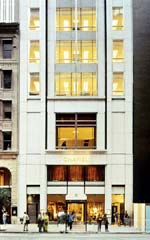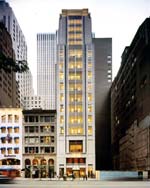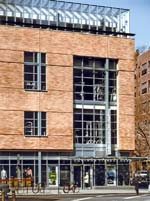
|

|
|
Home Site Search Contact Us Subscribe
|
|
The Architecture of Public Buildings The aspirations of a program that encourages good design should not be expressed in terms of style. The key difference between good and bad architecture is quality, not whether the structure is clad in rusticated limestone or perforated titanium. By Samuel G. White, FAIA January 28, 2021 The change in Federal regulations to favor Classical architecture for public buildings threatens to drag both the General Services Administration and the architectural profession back into the style wars of the 19th century. The Executive Order "Promoting Beautiful Federal Civic Architecture” not only creates a false paradigm, it ignores ideals that should inform every design, and particularly those for public architecture.
The aspirations of a program that encourages good design should not be expressed in terms of style, but in terms of quality. While design quality is a slippery concept, the best – and best loved – architecture of the past 3,000 years consistently illustrates a few timeless – and astylar – principles, which can be enumerated as follows:
· Honor the street: Whether we walk, jog, bike, scooter, or drive, the street is our one true public space. Physically and visually, the street belongs to us. Any structure that imposes itself on that precinct incurs an obligation to the public that can only be repaid through good design. This obligation, which begins with respect for the larger context of the neighborhood, is particularly apparent at street level. How the building meets the street, how it animates, strengthens, and welcomes the intimate relationship between architecture and humanity at street level is far more important than “style.” The New York Public Library honors the street it faces. The Seagram Building does as well, and so does a modest rowhouse with a front door surrounded by inviting details.
· Collaborations: Architecture is a visual art, but it is not the only one. It is, however, the art that creates an armature for the work of other artists and artisans, including sculptors, craftsmen, landscape designers, and those working in non-tactile media, including sound, video, and lighting. The best architecture makes room for these collaborations, and they in turn enrich the architecture, but collaboration is astylar.
· History: Architecture as we know it has been around for more than 3,000 years. Many architectural problems have been well solved before, and those older designs incorporate formal lessons that might apply to new problems. The best architects know their history and understand that those lessons can be distilled, abstracted, and reintroduced into new designs.
· The Modern: Architecture must constantly strive and adapt to address the social, technological, programmatic, economic, and aspirational realities of modern life. A new building doesn’t have to look like a spaceship, but more and more it has to work like one.
· Procession: public buildings are intended to ennoble us all, and the best of them dignify the ordinary activities based on movement, including arrival, entrance, waiting, assembly, circulation, and departure. Pathways should be legible and enjoyable, spaces should be comfortable, and the combination should dignify the people who use them and the activities that they accommodate.
· Spirit: Architecture should reflect and communicate the aspirations of its builders, its users, and in the case of public architecture, its community. The volume of that expression is controlled by the designer – some buildings shout, some whisper, but all good architecture has spirit.
· Beauty: Beauty may be in the eye of the beholder, but public architecture has many beholders and the designer is never going to please them all. At the same time, who is more important: the designer or the public? Artistic originality is a worthy ideal, but it is not the overriding goal of any project and the pursuit of originality should not neglect beauty.
The key difference between good and bad architecture is quality, not whether the structure is clad in rusticated limestone or perforated titanium. What the public needs in public architecture is more great design, period.
Images: The two projects at right were designed by Platt Byard Dovell several years before it merged with Buttrick White & Burtis. They are each over 20 years old, but they are handsome designs and they illustrate a number of the points made in this essay.
Both Chanel 57th Street and Equinox Greenwich Village have been altered in the past 20 years.
Also by White: "Stanford White in Detail" by Samuel G. White; photographs by Jonathan Wallen: A rich presentation of the sensual and scenographic effects created by the legendary architect (an excerpt from “Stanford White in Detail,” published by The Monacelli Press, October 2020).
Samuel G. White, FAIA, LEED AP, a great-grandson of Stanford White, is a consulting partner with New York City-based PBDW Architects. His diverse portfolio of educational, institutional, and residential projects focuses on designs that introduce new interventions to historic settings in ways that both reinforce and reinterpret their contexts. White’s recently completed work includes a new Net-Zero Energy dormitory for the Center for Development Economics at Williams College, expansion of Saint David’s School in New York City, restoration of the cast iron facades of 462 Broadway, and rehabilitation of the historic Bay Head Yacht Club in New Jersey. 462 Broadway, Poly Prep Lower School, and Duane Library have each been recipients of the Lucy G. Moses Preservation Award from the New York Landmarks Conservancy. His current projects include the modernization of Stanford White’s Astor Courts in Rhinebeck, NY. White is the author of The Houses of McKim, Mead & White; McKim, Mead & White: The Masterworks; Stanford White: Architect; and Nice House.
|
(click on pictures to enlarge)  Courtesy PBDW Architects Chanel 57th Street, as originally designed by Platt Byard Dovell: The fashion house’s flagship in New York City honors the Classical tradition while being indisputably contemporary; it also honors the street.  Courtesy PBDW Architects Chanel 57th Street: The storefront was altered by Peter Marino in 2018.  Courtesy PBDW Architects Equinox Greenwich Village, as originally designed by Platt Byard Dovell: A fully contemporary 40,000-square-foot building appropriate to the Greenwich Village Historic District.  Courtesy PBDW Architects Equinox Greenwich Village: The exterior that respected and complemented its place in this sensitive historic district was approved by the New York City Landmarks Preservation Commission. |
© 2021 ArchNewsNow.com